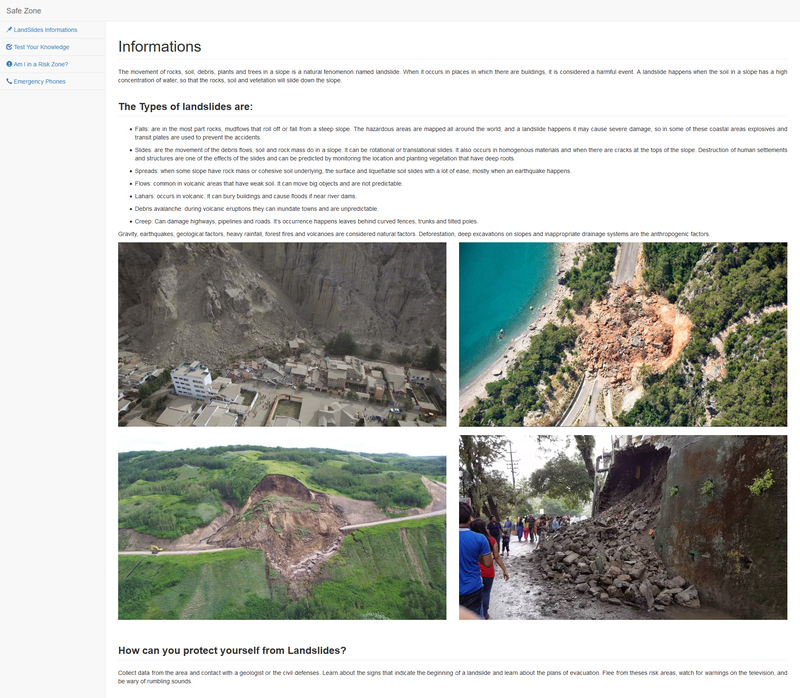Safe Zone | When Landslides Strike
The Challenge | When Landslides Strike
Landslide Safe
This application is an easy to use tool for people that don't have much information about the risks and most common causes of landslides.

The project is based on the research of UNICAMP about the dangerous locations mapping, and the law created by ONU in 1990 that intends to protect the people from natural disasters.
Main preventive measures from accidents related to landslides from the research include:
- Do not build houses the shores of a creek, over landfills or near wetlands;
- Do not throw waste in steep slopes, creek and manhole;
- Build houses in a higher level than local streams;
- Enhance seemingly fragile walls;
- Watch for curved trees, crack in the walls or on the floor and ground movement;
- Watch if the rain water is filled with mood and contains plants, trunks, because it is a inundation sign;
Inform the population that might not know that their home is in a dangerous zone. The application will provide 4 functionalities related to landslides: an informative page regarding landslides, 5 questions that will test your knowledge about your reaction in a disaster case, the contact number of related authorities and the possibility to check that your are is in a zone of risk, based on information of previous landslides, acquired through NASA's data.
Types of landslides
Falls: are in the most part rocks, mudflows that roll off or fall from a steep slope. The hazardous areas are mapped all around the world, and a landslide happens it may cause severe damage, so in some of these coastal areas explosives and transit plates are used to prevent the accidents.
Slides: are the movement of the debris flows, soil and rock mass do in a slope. It can be rotational or translational slides. It also occurs in homogenous materials and when there are cracks at the tops of the slope. Destruction of human settlements and structures are one of the effects of the slides and can be predicted by monitoring the location and planting vegetation that have deep roots.
Spreads: when some slope have rock mass or cohesive soil underlying, the surface and liquefiable soil slides with a lot of ease, mostly when an earthquake happens.
Flows: common in volcanic areas that have weak soil. It can move big objects and are not predictable.
Lahars: occurs in volcanic. It can bury buildings and cause floods if near river dams.
Debris avalanche: during volcanic eruptions they can inundate towns and are unpredictable.
Creep: Can damage highways, pipelines and roads. It’s occurrence happens leaves behind curved fences, trunks and tilted poles.
Gravity, earthquakes, geological factors, heavy rainfall, forest fires and volcanoes are considered natural factors. Deforestation, deep excavations on slopes and inappropriate drainage systems are the anthropogenic factors.
How can you protect yourself from Landslides?
Collect data from the area and contact with a geologist or the civil defenses. Learn about the signs that indicate the beginning of a landslide and learn about the plans of evacuation. Flee from theses risk areas, watch for warnings on the television, and be wary of rumbling sounds.
RESOURCES
Project source code: https://github.com/SafeZoneLS/Landslides
Landslide database: The Global Landslide Catalog (GLC) https://data.nasa.gov/dataset/Global-Landslide-Dat...
Landslide information source: DIGEST, Read. Landslides: Causes, Types & Effects of Landslides http://readanddigest.com/landslides-causes-types-effects-of-landslides/
Google Maps Javascript API: https://developers.google.com/maps/documentation/j...
SpaceApps is a NASA incubator innovation program.